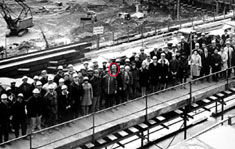 |
| Maikish |
For Charles Maikish, recently drafted by New York State to coordinate $21 billion worth of public and private investment in less than a square mile of densely packed lower Manhattan, its almost déja vu all over again. Maikish, as director of the World Trade Center during the Feb. 26, 1993 terrorist attack, led that fix.
But he is even more connected to the WTC than that. In 1968, Maikish started as a field engineer on the slurry wall. And from 1975-85, he worked as a port authority lawyer. One of his jobs was to defend construction claims against the original project.
This fourth time around, it is Maikishs job neither to build nor defend. But it might be his toughest assignment to date. For this time, he has to coordinate myriad owners and contractors. It also is his job to deal with residents concerns. This means monitoring construction-related air quality, noise pollution and traffic congestion. Maikish has to make sure it is business as usualwell nearlyduring the next six years.
 |
 |
| Then and Now. For Maikish (photo top- circled at left), it almost is déja vu all over again at the World Trade Center. Photo from 1968 (below) shows part of port authority team for original WTC. Photo (top,) shows members of city and state agencies involved in current lower Manhattan redevelopment. (Photo top by Guy Lawrence for ENR, bottom courtesy of ENR Charles Maikish) |
As the only one with expe-rience leading a post-attack WTC reconstruction, Maikish may be perfect for the job of coordination "czar." Still, the earlier job was a very different animal. In 1993, everyone was on the same page. "The vision was immensely clear," says Maikish, some five months into the job of executive director of the Lower Manhattan Construction Command Center, part of the states Lower Manhattan Development Corp. "If we didnt rebuild, the twin towers would sit as tombstones to the economy of lower Manhattan."
After the first attack, Maikish and his team got the twin 110-story towers reopened in less than four weeks. Then, the team went about the job of rebuilding the garage and the other hobbled systems. "One of the things we were able to do was erase the scar," he says. "We dont have the luxury this time to return to normalcy," he adds.
Under the current plan, "its a question of totally changing lower Manhattan to something bigger, better and greater than it was," but in a way that remembers and respects the victims of the Sept. 11, 2001 attacks, Maikish says.
Because of the multiple objectives and constituencies, the work demands a careful planning process that was not required in 1993. Planning now is giving way to action. "The cry that nothing has happened in four years is changing to a cry that too much is happening," says Maikish.
On the construction side, the biggest challenge Maikish faces is to change the "historical, cultural thinking" of the project delivery segment of the construction industry. He knows others have tried, mostly in vain. "Project directors, for good reasons, have long been focused on their project, done on their budget, to the exclusion of everyone else," says Maikish. "It is necessary, for it keeps people focused," he says.
Maikish is undaunted. He understands that for complex projects that interface, it is important to dispel tunnel vision. "Its about breaking down silos and sharing information," he says, adding that a gubernatorial and mayoral mandate helps.
|
The center has a three-word mantra: "facilitate" construction; "mitigate" the environmental impact and "communicate." For success, it comes down to logistics, so "we dont strangle ourselves, dont impede the flow of commerce and people and dont impair the ability of people to live," says Maikish.
With so much happening at once, "there is going to be a little bit of pain, there has to be," Maikish adds. But he believes that people will be tolerant if they know what to expect.
A little bit of pain may be understatement. Progress in lower Manhattan since Sept. 11, 2001, and especially at the 16-acre WTC site, has been measured in fits and starts, and fits and stops. In the past year alone, the 1,776-ft-tall Freedom Tower design was trashed and a new concept introduced, thanks to security concerns...

Post a comment to this article
Report Abusive Comment